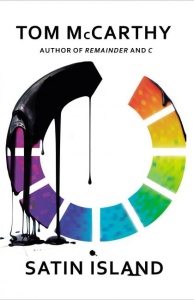 Tom McCarthy’s Satin Island was the only novel on the 2015 Booker shortlist that I had already read. When I try to recall it, recpature the experience of reading the thing in order to write a post hoc review of it, what I come back with primarily is blankness. This is no doubt inspired in part by the glooping blackness of the cover art, and also by the empty post-it notes which are evoked in its endpapers; but it’s also, I think, more or less the effect McCarthy was after: a literary lacuna, a mordant glance askance at our superficialised milieu.
Tom McCarthy’s Satin Island was the only novel on the 2015 Booker shortlist that I had already read. When I try to recall it, recpature the experience of reading the thing in order to write a post hoc review of it, what I come back with primarily is blankness. This is no doubt inspired in part by the glooping blackness of the cover art, and also by the empty post-it notes which are evoked in its endpapers; but it’s also, I think, more or less the effect McCarthy was after: a literary lacuna, a mordant glance askance at our superficialised milieu.
Here’s what I noted down about it in my reading diary (this entry of which is preserved in our What We Like Section on this very blog):
This is not C: it is not freewheeling and compendious, or expansive and confusing. A satire of late capitalism, Satin Island is the story of an anthropologist working as a researcher for a variety of consumerist brands, and he is open from the first about his bull-shitting trade; as the novel proceeds, however, even those ideas and thoughts he believes to have substance are revealed to have little purchase on significance. Almost everyone in the novel, regardless of their employer, is at work on the same Big Data-ish project, though none understand it; almost everyone searches for meaning and then doesn’t find it; and the novel ends, Gatsby-like, with a character letting a boat flow ever onwards … not into an ineffably recursive future, but a dirty harbour. Did we need Satin Island to know that late capitalism is a morass of self-negating contradictions? I’m not sure.
I’m not sure I need to add much to that, to be honest. Satin Island is far greater than its slim girth might suggest – it feels like an important novel in McCarthy’s pantheon,unlike, say, David Mitchell’s recent placeholder between projects. But by the same token it in some ways feels like a novel McCarthy would of course write, rather than one which surprises or startles. His earlier novel, C, was also nominated for the Booker but, in its twisting of the bildungsroman form into new shapes, or its frankly eccentric diction, it felt like a novel busting out o jail. Satin Island, meanwhile, draws a faithful scale drawing of the prison.
In the course of the novel, the narrator speaks directly to us at length about his life, and yet we are left more or less mystified as to its contexts. We follow him through episodes or even over-arching quests – interviews whi his gnomic boss, the ideas man Peyman (based, apparently, on McCarthy’s real-life friend and sparring partner, the Serpentine’s emperor of the contemporary, Hans-Ulrich Obrist), or visits to a colleague with cancer, or his continuing attempts to write something he calls the Great Report (a task for which he is supposedly employed by the corporation, but which never comes close to being begun, much less completed). These remain in weird ways like marooned components of an unfinished collage, however – floating between each other like underwear on a sparsely-populated washing line, identifiable but absurd.
The Great Report, of course, is both signifier and metaphor for this novelistic approach: like the Koob-Sassen Project, the great Big Data mission on which everyone the narrator encounters is working, it is ineffable and yet all-encompassing, both total and invisible. It is utterly pointless and worthy only of abandonment, and yet life without it would lack purpose of any kind. “The truly terrifying thought,” the narrator muses at one point, “wasn’t that the Great Report might be unwritable, but – quite the opposite – that it had already been written” (p. 123). That is, that it is in some way not being done by the narrator but being done to him, the system grown out of control.
On the very first page of the novel, we’re told that “people need foundation myths,” and if anything Satin Island is interested in being anti-origin story, a recursive feedback loop without any of the consolations or comforts of repetition. “There were scores of wakes,” the narrator observes of that dirty harbour at the novel’s end, “crossing each other in irregular and tangled patterns” (p. 171). At another juncture, he imagines himself in the final scene of Raiders of the Lost Ark, a man puttering down an endless hall, artefacts just as priceless as the one he is currently carrying stretching off to infinity. In this way, the narrator – like us all – is trapped within a self-replicating system of such bewildering fecundity that to cultivate any part of it is to allow a dozen others to grow wild. The Koob-Sassen Project – unknowable, unfinishable – is winning.
The thing is, I knew that Tom McCarthy – and most everyone else – though that about post-modernity, and Satin Island doesn’t add a great deal to ‘what next’ (even if ‘what next’ is a scenario straight out of a Charlie Stross novel, which it may well be). Perhaps ‘what next’ is another way of saying ‘so what’; perhaps requiring a next or a what is just my urge for a foundation myth whispering; either way, I think Satin Island gets its contrarian way with me. But what’s next?